Android--Jetpack--Navigation详解
须知少日拏云志,曾许人间第一流
一,定义
Navigation 翻译成中文就是导航的意思。它是谷歌推出的Jetpack的一员,其目的主要就是来管理页面的切换和导航。
Activity 嵌套多个 Fragment 的 UI 架构模式已经非常普遍,但是对 Fragment 的管理,我们一般通过 FragmentManager 和 FragmentTransaction 来管理 Fragment 之间的切换。页面的切换通常还包括对应用程序 App bar 的管理、Fragment 间的切换动画,以及 Fragment 间的参数传递。纯代码的方式使用起来不是特别友好,并且 Fragment 和 App bar 在管理和使用的过程中显得混乱。
使用Navigation可以很方便的管理和切换Fragment。
二,角色介绍
Navigation组件由三部分构成:
1)导航图(xml文件):包含所有导航相关信息的 XML 资源,其中包含所有目的地和操作。该图表会显示应用的所有导航路径。
2)NavHostFragment:导航宿主是 Navigation 组件的核心部分之一。导航宿主是一个空容器,用户在应用中导航时,目的地会在该容器中交换进出。
3)NavController:导航到目的地是使用NavController?完成的,它是一个在NavHost中管理应用导航的对象。每个NavHost均有自己的相应NavController?。
三,Navigation的优点
1)可视化的页面导航图,类似于 Apple Xcode 中的 StoryBoard,便于我们理清页面关系。
2)通过 destination 和 action 完成页面间的导航。
?3)方便添加页面切换动画。
?4)页面间类型安全的参数传递。
?5)通过 NavigationUI,对菜单、底部导航、抽屉菜单导航进行统一的管理。
四,基本使用
1,在app的build.gradle中添加引用:
implementation 'androidx.navigation:navigation-fragment:2.4.1'
implementation 'androidx.navigation:navigation-ui:2.4.1'2,在res目录下创建导航图(xml文件):
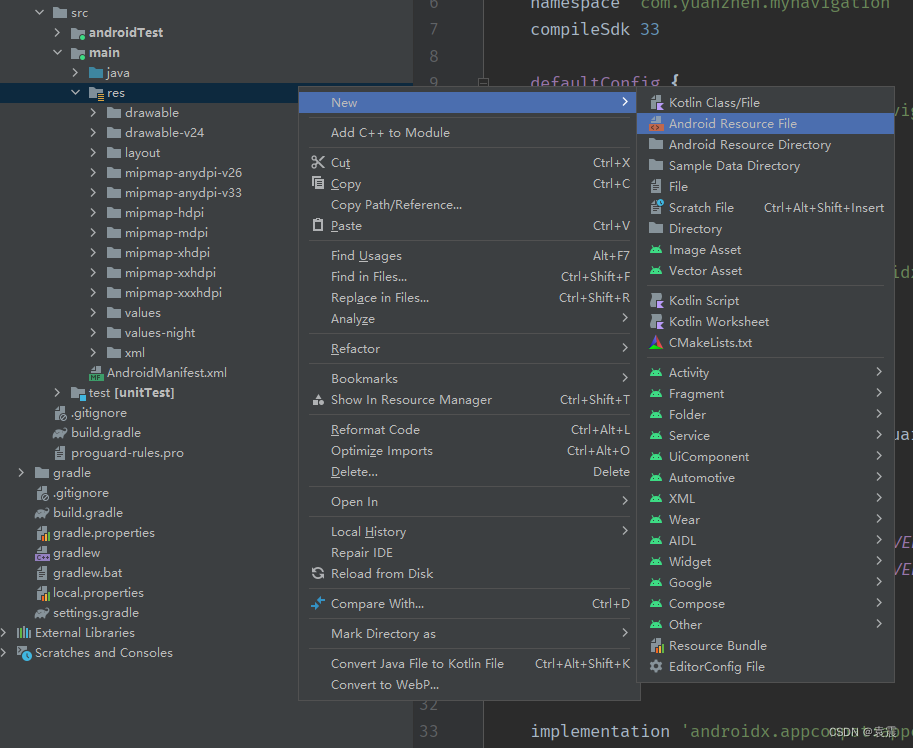
?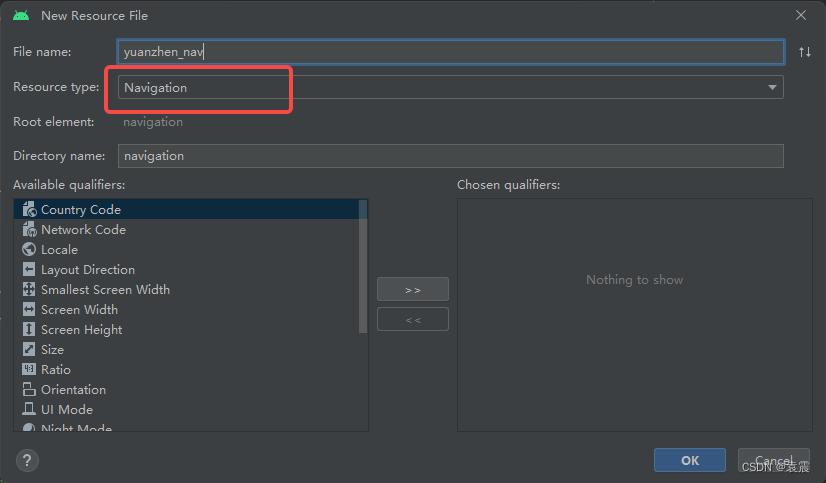
?点击ok就会生成xml文件
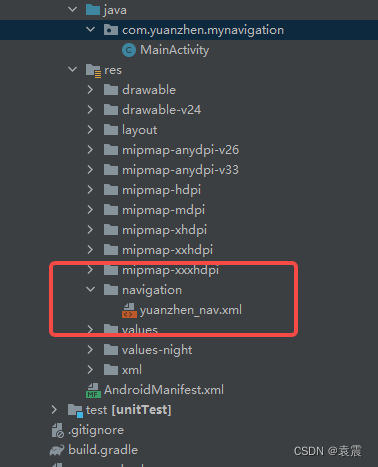
3,创建fragment:
创建三个fragment,分别为YZ1Fragment,YZ2Fragment,YZ3Fragment
public class YZ1Fragment extends Fragment {
@Nullable
@Override
public View onCreateView(@NonNull LayoutInflater inflater, @Nullable ViewGroup container, @Nullable Bundle savedInstanceState) {
return inflater.inflate(R.layout.fragment_yz1,container,false);
}
}fragment_yz1:
<?xml version="1.0" encoding="utf-8"?>
<androidx.constraintlayout.widget.ConstraintLayout xmlns:android="http://schemas.android.com/apk/res/android"
android:layout_width="match_parent"
android:layout_height="match_parent"
xmlns:app="http://schemas.android.com/apk/res-auto"
android:background="#223355">
<TextView
android:id="@+id/message"
android:layout_width="wrap_content"
android:layout_height="wrap_content"
android:text="我是第一页"
android:textSize="20sp"
android:textStyle="bold"
app:layout_constraintBottom_toBottomOf="parent"
app:layout_constraintEnd_toEndOf="parent"
app:layout_constraintStart_toStartOf="parent"
app:layout_constraintTop_toTopOf="parent" />
<Button
android:id="@+id/btn"
android:layout_width="wrap_content"
android:layout_height="wrap_content"
android:text="跳转第二页"
android:textAllCaps="false"
app:layout_constraintLeft_toLeftOf="parent"
app:layout_constraintRight_toRightOf="parent"
app:layout_constraintTop_toBottomOf="@+id/message" />
</androidx.constraintlayout.widget.ConstraintLayout>public class YZ2Fragment extends Fragment {
@Nullable
@Override
public View onCreateView(@NonNull LayoutInflater inflater, @Nullable ViewGroup container, @Nullable Bundle savedInstanceState) {
return inflater.inflate(R.layout.fragment_yz2,container,false);
}
}fragment_yz2:
<?xml version="1.0" encoding="utf-8"?>
<androidx.constraintlayout.widget.ConstraintLayout xmlns:android="http://schemas.android.com/apk/res/android"
android:layout_width="match_parent"
android:layout_height="match_parent"
xmlns:app="http://schemas.android.com/apk/res-auto"
android:background="#dd2233">
<TextView
android:id="@+id/textView"
android:layout_width="wrap_content"
android:layout_height="wrap_content"
android:layout_marginLeft="8dp"
android:layout_marginRight="8dp"
android:layout_marginBottom="16dp"
android:text="第二页"
android:textSize="20sp"
android:textStyle="bold"
app:layout_constraintBottom_toBottomOf="parent"
app:layout_constraintEnd_toEndOf="parent"
app:layout_constraintStart_toStartOf="parent"
app:layout_constraintTop_toTopOf="parent" />
<Button
android:id="@+id/btn"
android:layout_width="wrap_content"
android:layout_height="wrap_content"
android:layout_marginStart="8dp"
android:layout_marginLeft="8dp"
android:layout_marginEnd="8dp"
android:layout_marginRight="8dp"
android:text="返回第一页"
android:textAllCaps="false"
app:layout_constraintEnd_toEndOf="parent"
app:layout_constraintStart_toStartOf="parent"
app:layout_constraintTop_toBottomOf="@+id/textView" />
<Button
android:id="@+id/btn2"
android:layout_width="wrap_content"
android:layout_height="wrap_content"
android:layout_marginStart="8dp"
android:layout_marginLeft="8dp"
android:layout_marginEnd="8dp"
android:layout_marginRight="8dp"
android:text="前往第三页"
android:textAllCaps="false"
app:layout_constraintEnd_toEndOf="parent"
app:layout_constraintStart_toStartOf="parent"
app:layout_constraintTop_toBottomOf="@+id/btn" />
</androidx.constraintlayout.widget.ConstraintLayout>public class YZ3Fragment extends Fragment {
@Nullable
@Override
public View onCreateView(@NonNull LayoutInflater inflater, @Nullable ViewGroup container, @Nullable Bundle savedInstanceState) {
return inflater.inflate(R.layout.fragment_yz3,container,false);
}
}fragment_yz3:
<?xml version="1.0" encoding="utf-8"?>
<androidx.constraintlayout.widget.ConstraintLayout xmlns:android="http://schemas.android.com/apk/res/android"
android:layout_width="match_parent"
android:layout_height="match_parent"
xmlns:app="http://schemas.android.com/apk/res-auto"
android:background="#33ff22">
<TextView
android:id="@+id/textView"
android:layout_width="wrap_content"
android:layout_height="wrap_content"
android:layout_marginLeft="8dp"
android:layout_marginRight="8dp"
android:layout_marginBottom="16dp"
android:text="第三页"
android:textSize="20sp"
android:textStyle="bold"
app:layout_constraintBottom_toBottomOf="parent"
app:layout_constraintEnd_toEndOf="parent"
app:layout_constraintStart_toStartOf="parent"
app:layout_constraintTop_toTopOf="parent" />
<Button
android:id="@+id/btn"
android:layout_width="wrap_content"
android:layout_height="wrap_content"
android:layout_marginStart="8dp"
android:layout_marginLeft="8dp"
android:layout_marginEnd="8dp"
android:layout_marginRight="8dp"
android:text="跳到第二页"
android:textAllCaps="false"
app:layout_constraintEnd_toEndOf="parent"
app:layout_constraintStart_toStartOf="parent"
app:layout_constraintTop_toBottomOf="@+id/textView" />
</androidx.constraintlayout.widget.ConstraintLayout>4,回到yuanzhen_nav.xml中,点击添加:
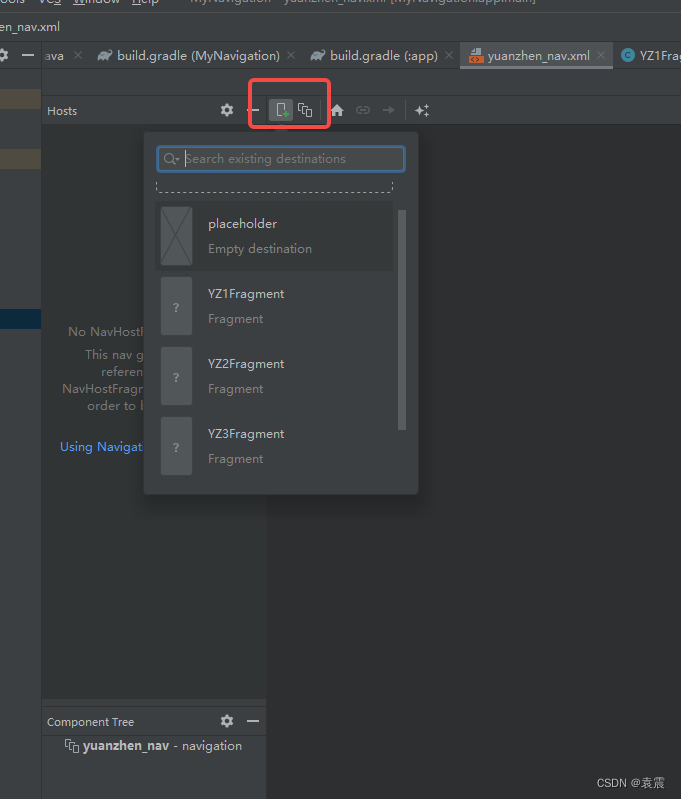
添加三个fragment :
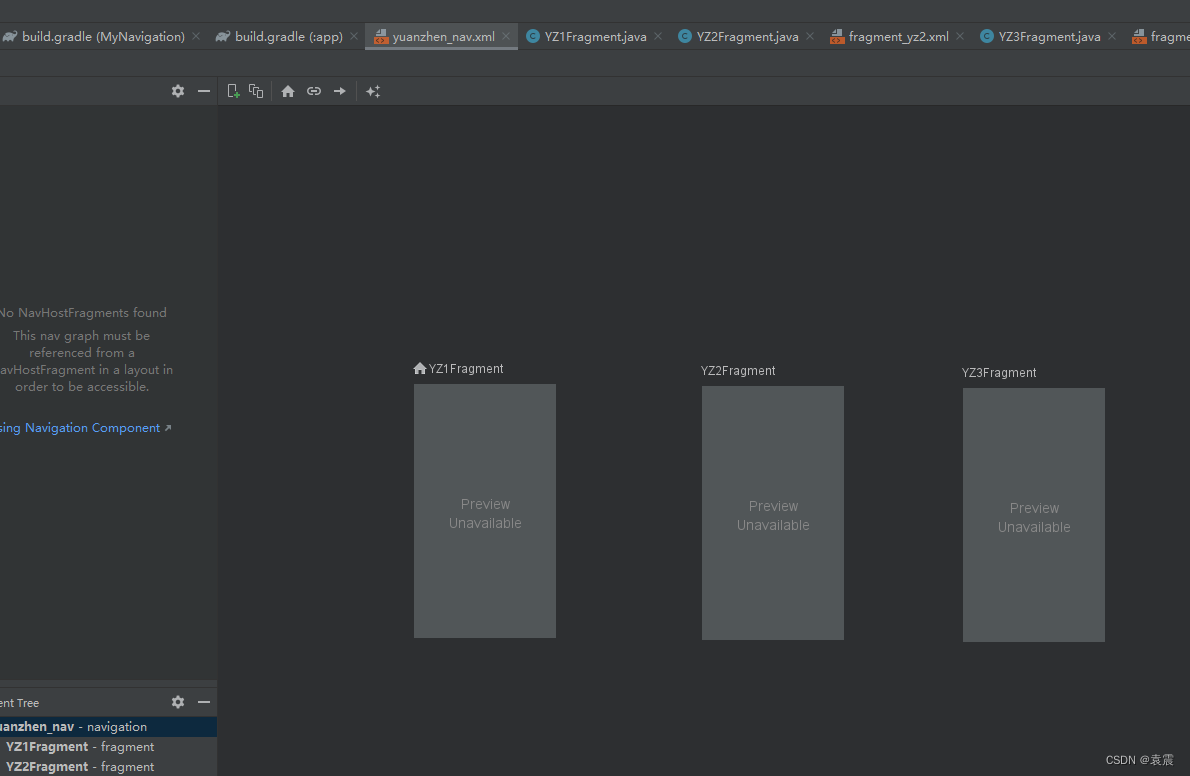
然后收到添加跳转方向:
?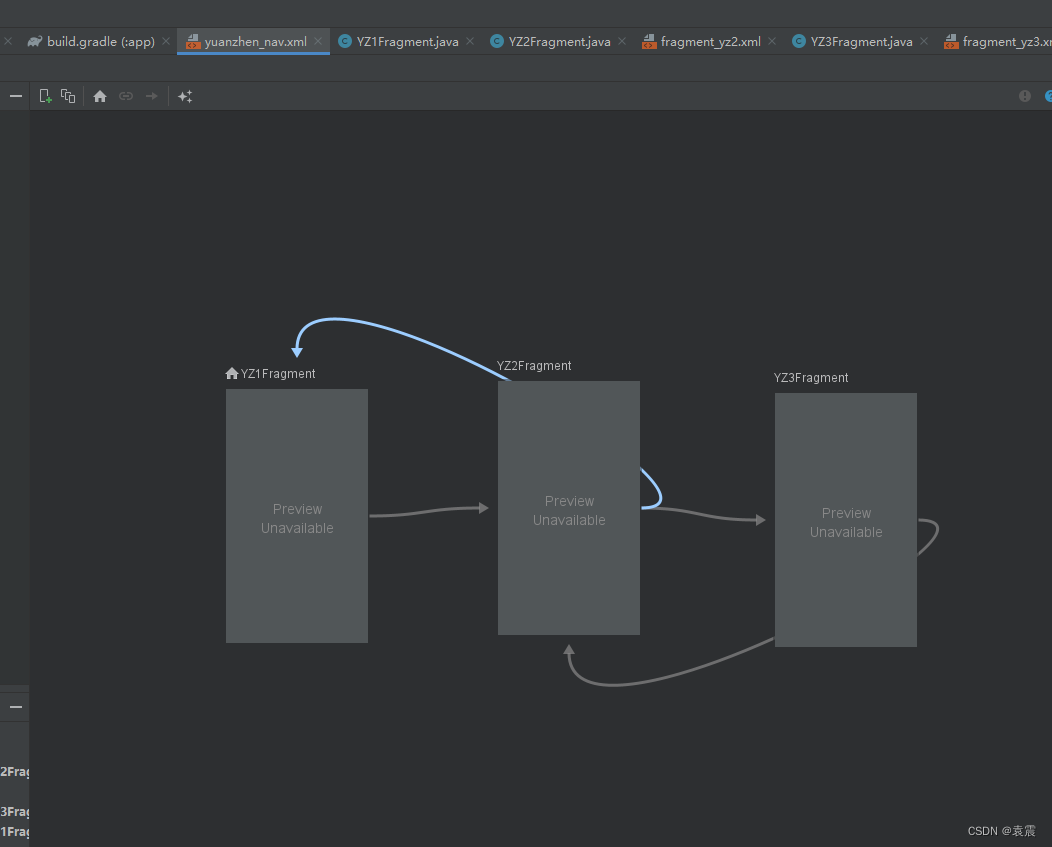
?就会自动生成代码:
<?xml version="1.0" encoding="utf-8"?>
<navigation xmlns:android="http://schemas.android.com/apk/res/android"
xmlns:app="http://schemas.android.com/apk/res-auto"
android:id="@+id/yuanzhen_nav"
app:startDestination="@id/YZ1Fragment">
<fragment
android:id="@+id/YZ1Fragment"
android:name="com.yuanzhen.mynavigation.YZ1Fragment"
android:label="YZ1Fragment" >
<action
android:id="@+id/action_YZ1Fragment_to_YZ2Fragment2"
app:destination="@id/YZ2Fragment" />
</fragment>
<fragment
android:id="@+id/YZ2Fragment"
android:name="com.yuanzhen.mynavigation.YZ2Fragment"
android:label="YZ2Fragment" >
<action
android:id="@+id/action_YZ2Fragment_to_YZ3Fragment2"
app:destination="@id/YZ3Fragment" />
<action
android:id="@+id/action_YZ2Fragment_to_YZ1Fragment2"
app:destination="@id/YZ1Fragment" />
</fragment>
<fragment
android:id="@+id/YZ3Fragment"
android:name="com.yuanzhen.mynavigation.YZ3Fragment"
android:label="YZ3Fragment" >
<action
android:id="@+id/action_YZ3Fragment_to_YZ2Fragment2"
app:destination="@id/YZ2Fragment" />
</fragment>
</navigation>这里的action代表的就是跳转路径。
5,在fragment中实现跳转代码:
public class YZ1Fragment extends Fragment {
@Nullable
@Override
public View onCreateView(@NonNull LayoutInflater inflater, @Nullable ViewGroup container, @Nullable Bundle savedInstanceState) {
return inflater.inflate(R.layout.fragment_yz1,container,false);
}
@Override
public void onViewCreated(@NonNull View view, @Nullable Bundle savedInstanceState) {
super.onViewCreated(view, savedInstanceState);
Button btn=view.findViewById(R.id.btn);
btn.setOnClickListener(new View.OnClickListener() {
@Override
public void onClick(View view) {
Navigation.findNavController(view).navigate(R.id.action_YZ1Fragment_to_YZ2Fragment2);
}
});
}
}public class YZ2Fragment extends Fragment {
@Nullable
@Override
public View onCreateView(@NonNull LayoutInflater inflater, @Nullable ViewGroup container, @Nullable Bundle savedInstanceState) {
return inflater.inflate(R.layout.fragment_yz2,container,false);
}
@Override
public void onViewCreated(@NonNull View view, @Nullable Bundle savedInstanceState) {
super.onViewCreated(view, savedInstanceState);
Button btn=view.findViewById(R.id.btn);
btn.setOnClickListener(new View.OnClickListener() {
@Override
public void onClick(View view) {
Navigation.findNavController(view).navigate(R.id.action_YZ2Fragment_to_YZ1Fragment2);
}
});
Button btn2=view.findViewById(R.id.btn2);
btn2.setOnClickListener(new View.OnClickListener() {
@Override
public void onClick(View view) {
Navigation.findNavController(view).navigate(R.id.action_YZ2Fragment_to_YZ3Fragment2);
}
});
}
}public class YZ3Fragment extends Fragment {
@Nullable
@Override
public View onCreateView(@NonNull LayoutInflater inflater, @Nullable ViewGroup container, @Nullable Bundle savedInstanceState) {
return inflater.inflate(R.layout.fragment_yz3,container,false);
}
@Override
public void onViewCreated(@NonNull View view, @Nullable Bundle savedInstanceState) {
super.onViewCreated(view, savedInstanceState);
Button btn=view.findViewById(R.id.btn);
btn.setOnClickListener(new View.OnClickListener() {
@Override
public void onClick(View view) {
Navigation.findNavController(view).navigate(R.id.action_YZ3Fragment_to_YZ2Fragment2);
}
});
}
}6,在Activity添加fragment:
public class MainActivity extends AppCompatActivity {
private NavController navController;
@Override
protected void onCreate(Bundle savedInstanceState) {
super.onCreate(savedInstanceState);
setContentView(R.layout.activity_main);
navController = Navigation.findNavController(this, R.id.frag);
NavigationUI.setupActionBarWithNavController(this, navController);
}
}activity_main:
<?xml version="1.0" encoding="utf-8"?>
<androidx.constraintlayout.widget.ConstraintLayout xmlns:android="http://schemas.android.com/apk/res/android"
xmlns:app="http://schemas.android.com/apk/res-auto"
xmlns:tools="http://schemas.android.com/tools"
android:layout_width="match_parent"
android:layout_height="match_parent"
tools:context=".MainActivity">
<fragment
android:id="@+id/frag"
android:layout_width="match_parent"
android:layout_height="match_parent"
app:defaultNavHost="true"
android:name="androidx.navigation.fragment.NavHostFragment"
app:layout_constraintBottom_toBottomOf="parent"
app:layout_constraintEnd_toEndOf="parent"
app:layout_constraintStart_toStartOf="parent"
app:layout_constraintTop_toTopOf="parent"
app:navGraph="@navigation/yuanzhen_nav"/>
</androidx.constraintlayout.widget.ConstraintLayout>运行效果:

?五,添加导航栏
1,在res目录下添加menu:
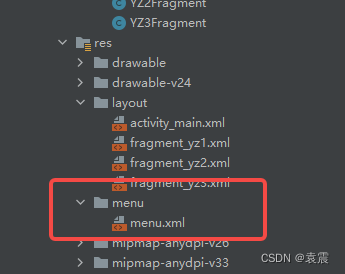
2,menu.xml:
<?xml version="1.0" encoding="utf-8"?>
<menu xmlns:android="http://schemas.android.com/apk/res/android">
<item
android:id="@+id/YZ1Fragment"
android:icon="@mipmap/pic_article_default"
android:title="首页"/>
<item
android:id="@+id/YZ2Fragment"
android:icon="@mipmap/tell_normal"
android:title="第二页"/>
<item
android:id="@+id/YZ3Fragment"
android:icon="@mipmap/video_call_default"
android:title="第三页"/>
</menu>注意,这里的id就是你要跳转的fragment名称
3,在activity_main添加新的布局:
<?xml version="1.0" encoding="utf-8"?>
<LinearLayout xmlns:android="http://schemas.android.com/apk/res/android"
xmlns:app="http://schemas.android.com/apk/res-auto"
xmlns:tools="http://schemas.android.com/tools"
android:layout_width="match_parent"
android:layout_height="match_parent"
tools:context=".MainActivity"
android:orientation="vertical">
<fragment
android:id="@+id/frag"
android:layout_width="match_parent"
android:layout_height="wrap_content"
android:layout_weight="9"
app:defaultNavHost="true"
android:name="androidx.navigation.fragment.NavHostFragment"
app:layout_constraintBottom_toBottomOf="parent"
app:layout_constraintEnd_toEndOf="parent"
app:layout_constraintStart_toStartOf="parent"
app:layout_constraintTop_toTopOf="parent"
app:navGraph="@navigation/yuanzhen_nav"/>
<com.google.android.material.bottomnavigation.BottomNavigationView
android:id="@+id/btm"
android:layout_width="match_parent"
android:layout_height="wrap_content"
android:layout_weight="1"
app:menu="@menu/menu"/>
</LinearLayout>4,在MainActivity添加代码:
public class MainActivity extends AppCompatActivity {
private NavController navController;
BottomNavigationView bottomNavigationView;
@Override
protected void onCreate(Bundle savedInstanceState) {
super.onCreate(savedInstanceState);
setContentView(R.layout.activity_main);
bottomNavigationView=findViewById(R.id.btm);
navController = Navigation.findNavController(this, R.id.frag);
NavigationUI.setupWithNavController(bottomNavigationView,navController);
}
}实现效果:

?六,添加动画效果
添加动画效果非常简单:
1,打开yuanzhen_nav.xml文件
2,点击试图的跳转线:

3,?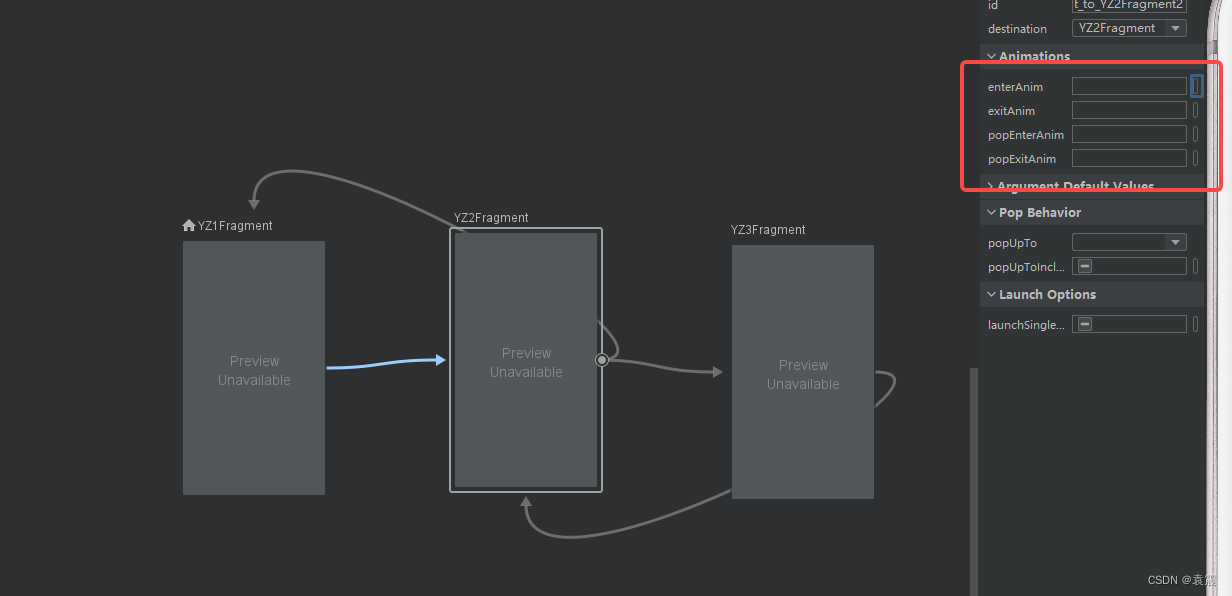
有四个动画可以选择
选择之后yaunzhen_nav文件如下:
<?xml version="1.0" encoding="utf-8"?>
<navigation xmlns:android="http://schemas.android.com/apk/res/android"
xmlns:app="http://schemas.android.com/apk/res-auto"
android:id="@+id/yuanzhen_nav"
app:startDestination="@id/YZ1Fragment">
<fragment
android:id="@+id/YZ1Fragment"
android:name="com.yuanzhen.mynavigation.YZ1Fragment"
android:label="YZ1Fragment" >
<action
android:id="@+id/action_YZ1Fragment_to_YZ2Fragment2"
app:destination="@id/YZ2Fragment"
app:enterAnim="@anim/nav_default_pop_enter_anim"
app:exitAnim="@anim/nav_default_pop_enter_anim"
app:popEnterAnim="@anim/nav_default_pop_exit_anim"
app:popExitAnim="@anim/nav_default_pop_exit_anim" />
</fragment>
<fragment
android:id="@+id/YZ2Fragment"
android:name="com.yuanzhen.mynavigation.YZ2Fragment"
android:label="YZ2Fragment" >
<action
android:id="@+id/action_YZ2Fragment_to_YZ3Fragment2"
app:destination="@id/YZ3Fragment"
app:enterAnim="@anim/nav_default_enter_anim"
app:exitAnim="@anim/nav_default_exit_anim"
app:popEnterAnim="@anim/nav_default_enter_anim"
app:popExitAnim="@anim/nav_default_pop_exit_anim" />
<action
android:id="@+id/action_YZ2Fragment_to_YZ1Fragment2"
app:destination="@id/YZ1Fragment" />
</fragment>
<fragment
android:id="@+id/YZ3Fragment"
android:name="com.yuanzhen.mynavigation.YZ3Fragment"
android:label="YZ3Fragment" >
<action
android:id="@+id/action_YZ3Fragment_to_YZ2Fragment2"
app:destination="@id/YZ2Fragment" />
</fragment>
</navigation>也可以自己去自定义动画
本文来自互联网用户投稿,该文观点仅代表作者本人,不代表本站立场。本站仅提供信息存储空间服务,不拥有所有权,不承担相关法律责任。 如若内容造成侵权/违法违规/事实不符,请联系我的编程经验分享网邮箱:veading@qq.com进行投诉反馈,一经查实,立即删除!